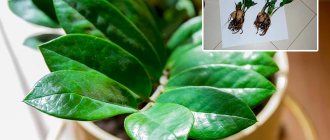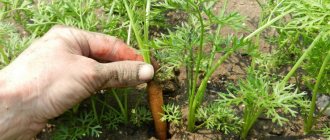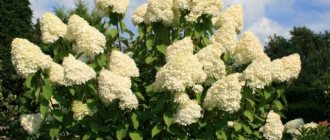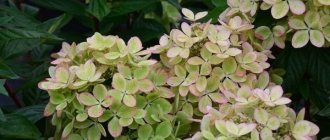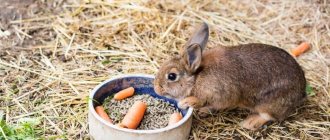There are many varieties of hydrangea; it is grown both in the garden and at home, as a houseplant. Contrary to popular belief, hydrangea is unpretentious. But in order for the plant to fully develop and bloom luxuriantly, you need to choose the right place for it, plant it correctly and provide the hydrangea with the necessary care. This can hardly be called whims, since any garden crop requires good care. So if there are problems with your hydrangea, then the reason must be sought in caring for the plant or improper planting. This article will help you find answers to the question of why the growth and development of hydrangea is slowing down.
General information.
Today there are approximately eighty varieties of this beautiful plant. In the garden you can grow panicle, tree or serrate hydrangeas, but as a houseplant the most common are compact dwarf varieties of large-leaved hydrangea.
In our country, deciduous varieties of hydrangea are grown, most of them need shelter for the winter, since they are a heat-loving plant. Depending on the variety, inflorescences form on young branches or last year’s shoots; it is important to find out this point when purchasing seedlings, since if you don’t know, you can harm the plant by improper pruning.
The undoubted advantage of hydrangea over other plants is that it is extremely resistant to disease and is sharply affected by harmful insects.
The color of hydrangea inflorescences is extremely varied; you can see white and cream flowers, different shades of blue, lilac and pink. The most interesting in this regard are some varieties of large-leaved hydrangea, since they are able to change the color of their flowers depending on the composition of the soil. By planting this hydrangea in acidic soil with a high aluminum content, you will admire blue-blue flowers. And if you regularly add alkaline additives to the bush, then over time the color of the inflorescences will change to pink.
Resuscitation of hydrangea after winter
If the plant has not been properly prepared for winter, it may survive, but it will look sick and unsightly. When a hydrangea does not grow after winter, turns black, and there are spots on its leaves, you can easily understand that, most likely, the bush is frozen or attacked by pests or a fungus.
It is possible to revive a weakened plant; for this you will need to carry out a series of restorative procedures.
- If there are symptoms of insects, spraying with insecticides will be necessary. Spraying Bordeaux mixture helps against various types of fungus, but in case of total infection, it is wiser to get rid of the damaged foliage and only then treat it with fungicides.
- The problem of poor growth when hydrangea does not wake up can be solved using complex means. Replenishing the nutritional components will help revive the plant, and next year the crop will again delight you with lush flowering.
- There is also a possibility that the soil composition was the cause. All hydrangeas love acidic soil to one degree or another, but over time they take away the acid from it. This means that it will be necessary to acidify the soil, and for this it is not necessary to choose potent drugs. Acidification is carried out using the usual means that are available in every home: oxalic acid, succinic acid, citric acid or lemon juice, potassium nitrate and electrolyte solution.
It is better to avoid any vinegar solutions, as they can destroy colonies of beneficial microorganisms in the soil, and the optimal balance of the natural environment will be disrupted.
When growing such an amazingly beautiful plant as hydrangea in your garden, you cannot neglect the requirements for its maintenance. Timely agricultural technology, pruning and protective measures on the eve of cold weather will help preserve the crop and maintain it in a healthy (in all respects), flourishing state.
You will learn how to care for hydrangea in early spring from the following video.
Propagation of hydrangea by dividing the bush, cuttings and layering.
Depending on the climate of the region in which you live, hydrangea can be planted in spring or autumn (the main thing is that the plant has time to take root well before winter). The place for the plant must be selected and prepared in advance; it must be protected from the wind and from direct sunlight during the daytime. But hydrangea will not grow in the shade either, so it is very important to choose a certain light regime for the plant: sun in the morning, light partial shade in the afternoon.
Hydrangea is propagated by dividing the bush, rooting cuttings or layering. You can also grow it from seeds, but since it will take at least two years to grow seedlings, this method is not particularly popular.
When planting, you need to dig a fairly large hole, lay drainage and a specially prepared mixture of sand, garden soil and peat in equal proportions with the addition of superphosphate at the bottom. When filling the seedling with soil, make sure that the root collar is a couple of centimeters above the soil level. The soil should be lightly compacted and the plant should be watered abundantly.
If you propagate hydrangea by dividing the bush, then make sure that each part has healthy and strong roots, then the plant will take root faster in a new place.
Planting can be done both in spring and autumn.
If you have to root cuttings, then in the fall you need to dig up the mother bush and transplant it into a container, place it in a cool room for the winter, water it moderately, and by the end of winter begin to gradually raise the air temperature. When the hydrangea comes out of dormancy and begins to grow, you need to cut off its young apical shoots, cut off the leaves on them in half and plant them in nutritious soil, covering the top with a jar or a cut plastic bottle (you get an impromptu greenhouse). You will know that rooting has taken place by the fresh leaves that appear, after which the greenhouse can be removed. When rooting cuttings, you need to dig in one branch without cutting it off from the plant. After a few months, sprouts will appear in this place, therefore, the hydrangea has taken root, you can cut off the shoot and replant it in a new place. The best time to bury the shoot is in the fall, when you are preparing the hydrangea for winter.
Care in autumn and winter
Why doesn't hydrangea bloom for a long time?
In autumn, watering hydrangeas should be reduced and vitamin and mineral phosphorus-potassium fertilizers added. The roots are mulched with sawdust, dry leaves, pine needles, and crushed pine bark. In winter, the roots can be additionally sprinkled with snow.
When hydrangea does not grow well after winter, the reason lies in its pruning in the fall. It is necessary to prune so that the branches are not damaged in winter: cut off the lower and middle leaves, which can be infected and damaged by fungal spores, and shoots, leaving only up to five healthy and strong ones.
Hydrangea propagation. shoot
During the winter months, hydrangeas should be covered as soon as the first frost occurs. This especially applies to small bushes of the plant. Rain film can be used as a covering material. During severe frosts, wooden boxes are used, lined with heat-insulating material on the inside.
For your information. You especially need to watch the upper branches. At night, the temperature often drops and the branches may freeze.
Hydrangea varieties such as paniculata and tree hydrangea require pruning of branches in spring. Otherwise, the branches grow strongly and quickly in height and may break off under their own weight.
To help the plant grow well, the soil needs to be fed with ammonium sulfate and potassium sulfate - physiologically acidic fertilizers. You need to pour 2-3 buckets of fertilizer solution under the root.
Be sure to weed the weeds, remove old leaves, loosen the soil and mulch the bush with a thick layer of peat.
As soon as the snow melts, the hydrangea must be released from its shelter so that it does not fall apart. During spring frosts, to prevent the plant from freezing, it is necessary to cover it again, otherwise the shoots that began to grow quickly in the fresh air may die.
Caring for hydrangea in the autumn-winter period.
Hydrangea is moisture-loving, but in the autumn it needs to be watered less, and if the autumn is rainy, then watering is completely unnecessary; you may even have to make a canopy over the bush to protect it from waterlogging. When carrying out the last fertilizing in September-October, remove all weeds from the tree trunk circle, loosen the soil, apply potassium and phosphorus fertilizers under the hydrangea, then you need to hill the base of the bush with dry soil and thoroughly mulch the tree trunk circle. Experts do not recommend formative pruning of hydrangeas in the fall, but it is still necessary to remove all damaged shoots, remnants of leaves and faded inflorescences. When the first frosts occur, the hydrangea must be wrapped. If the branches are flexible enough, then they are laid on the ground, having previously placed boards or spruce branches, fastened, covered with dry leaves or the same spruce branches, and geotextiles are laid and fixed on top. If the hydrangea branches do not bend, then they are collected in a bunch and wrapped in several layers with old blankets, burlap or non-woven fabric. If the hydrangea is not tall, then you can cover it with a box or box, filling the inner space with dry foliage.
What to do if hydrangea does not grow
If after planting the shrub retains its original size for a long time, you need to pay attention to the composition of the soil and the abundance of sunlight. To accelerate the growth of hydrangeas, fertilizers with iron and nitrogen are added to the soil, and mineral complexes are added to the soil before flowering.
Sunlight is also important for the growth of any variety of hydrangea. Each of them develops well in partial shade, but petiole hydrangea does not grow in the sun. She prefers completely shaded, windless areas with acidic, loose, humus-rich soil.
The first few years, even with successful planting, petiole hydrangea grows slowly
In calcareous soils with insufficient acidity, any variety will not grow. Also, chernozems, soil fertilized with manure or humus, are destructive for the crop.
Watering is especially important for the growth of hydrangea - this crop quickly dies during drought. Moisten the bush with a watering can. The water should be dispersed so as not to expose the plant's surface roots. The liquid is pre-settled; it should not be cold.
Watering is carried out only in the early morning or evening, after sunset. The fastidious crop should not be exposed to sunlight after moistening. An adult bush needs 1-2 buckets of water per procedure. In hot summers, watering is carried out every other day or 2 times a week. Only with plenty of moisture does the shrub grow well.
If gray, whitish or rusty spots appear on the leaves of the hydrangea, this is a fungal disease. Because of this, the shrub grows weakly and stops blooming. The bush is sprayed with fungicides 1-2 times a week until signs of the disease completely disappear.
A garlic-soap solution will rid the plant of any pests. It is prepared like this: 0.5 kg of garlic is peeled, the cloves are crushed in a blender. The resulting slurry is poured into 2 liters of water and left for 2 days. Afterwards, grate a bar of laundry soap and combine it with infused and strained garlic water. The liquid is sprayed on garden plants, cleaning them from slugs, snails, leaf rollers, and spider mites.
Hydrangea leaves affected by mites dry out and fall off, after which the crop does not grow
Fufan or Teofos insecticides are also used to control the pest.
In spring, it is important to prune hydrangeas to speed up the growth of young shoots. In the fall, it is better not to remove the branches of the current year, since it is on them that the flower buds of the next season are laid.
Serrated, oak-leaved, and prickly hydrangeas are trimmed minimally (only the tips of old shoots). Thorough pruning can stunt the growth of these types of hydrangeas.
Timely covering of hydrangeas for the winter will preserve the integrity of the shoots and flower buds. In the new season, such a flower will grow well, releasing leaves when the first rays of the sun appear.
Tree and paniculate hydrangeas are characterized by increased frost resistance; in the southern and central regions of Russia they are not covered. For a successful wintering of these crops, it is enough to mulch the tree trunk well.
Top the mulch with a thick layer of dry fallen leaves.
All other types of hydrangeas require multi-layer cover for the winter. If the crop successfully overwinters and does not freeze, it will grow well in the spring and bloom early.
Reasons for the slow growth of hydrangea.
There are a number of reasons why hydrangea growth may slow down, the number of inflorescences may decrease, or flowering may not occur at all. 1. Improper preparation of the plant for winter. If you did not protect the hydrangea from heavy autumn rains, then the root system could begin to rot in the winter. The shoots could freeze if the shelter was not of sufficient quality. The root system of hydrangea is shallow, so there is a risk of damaging it in the process of loosening the soil; this must be done very carefully. Well, if you transplanted the hydrangea too late in the fall, then perhaps it did not have time to take root and froze in the winter.
2. As we have already said, the light regime is very important for hydrangea; it will not bloom if planted in the shade of buildings or other taller plants. But even being in the sun all day, it will not feel comfortable, the inflorescences will be crushed, and the foliage will lose its beautiful juicy green tint. Therefore, the place must be chosen so that during the hottest daytime the hydrangea is protected from the sun. 3. Insufficient watering or watering with too hard water can also cause stunted hydrangea growth. The plant is extremely moisture-loving; an adult bush requires about two buckets of water weekly (watering should be done early in the morning or in the evening), and if the weather is dry, then the plants need to be watered more often. Before watering, the water must be left to settle for several days; you can additionally acidify it with citric acid or vinegar. In the first weeks after planting, you need to water the hydrangea more often, as this promotes rapid rooting. But with all the love of hydrangea for water, it is very important not to allow the soil to become waterlogged; this can be as detrimental to the plant as a lack of moisture. 4. Hydrangea, unlike many other garden crops, prefers acidic soil. In an alkaline environment, it feels less comfortable; a lack of iron can lead to chlorosis of the plant. Before planting, it is necessary to find out the acidity of the soil, and if it turns out to be insufficiently suitable for hydrangea, the situation can be corrected with the help of ferrous sulfate, ammonium sulfate, as well as oxalic, citric or acetic acid. 5. Like any other plant, hydrangea requires additional nutrition. If fertilizers are not applied in a timely manner, the plant experiences a nutrient deficiency and its growth stops.
Hydrangea grows poorly: why and how to help the flower?
Hydrangea is a favorite flower of many gardeners. Hydrangea pleases with its flowering both at home and in the garden. Many gardeners have problems with the growth of this flower in the garden, and the reason lies in the fact that hydrangea is demanding of care. This article describes the main causes of poor growth and what to do about it.
Poor growth of hydrangea can be due to many reasons, the main ones:
- insufficient sun saturation;
- uncontrolled watering;
- low soil acidity;
- lack of fertilizers or improper feeding;
- pests;
- diseases;
- damage and rotting of the root system.
Let's look at each reason in more detail.
Not enough sun
Hydrangea is a sun-loving plant, but you need to be careful not to overdo it. Exposure to too much direct sunlight can damage the plant and burn the flowers.
Improper watering
You cannot use hard water when watering this plant; you must use soft water. You can get such water by collecting rain or running water and letting it sit for 4 days. Hydrangea has a sensitive root system, so the water for irrigation should be warm with a temperature of about 15 degrees.
Watering should be done in the morning or evening so that the sun does not evaporate moisture from the soil. Each bush requires 15 liters of warm water weekly.
Soil acidity
Hydrangeas may develop poorly or fail to grow due to alkaline soil with too much lime, and this can lead to the death of the plant.
In this case, it is recommended to transplant the plant into another soil, and if there is no such place, then the condition of the plant can be improved by fertilizing with iron sulfate, which must be taken in the amount of 5 grams per 10 liters of water.
Incorrect feeding/fertilizer
The plant is very finicky, and insufficient or too much fertilizer can lead to poor growth and disease of the plant. It’s better to buy fertilizer in a store ; if that doesn’t work out, you can make it yourself.
Pests
Hydrangea is susceptible to invasion by pests such as aphids, spider mites, root-knot nematodes, slugs, snails and others. Slugs or snails can be removed by hand. Against other pests, it is necessary to use special solutions. Signs of pests are:
- wilting of foliage;
- yellowing and falling leaves;
- deformation of flowers, sprouts and inflorescences;
- drying out.
If such signs are present, the plant must be urgently saved.
How to care for hydrangea in early spring.
In the spring, as soon as the snow melts, you need to gradually unwrap the hydrangea so that it does not begin to rot under cover. First, remove the cover during the day, and then cover the hydrangea with geotextile again at night. Then, with the onset of steadily warm weather, the shelter can be removed completely.
When watering for the first time, add a little potassium permanganate to the water to create a light pink solution, this way you will disinfect the soil. You can spray the branches of hydrangea with the same solution, this will make them more flexible.
The first feeding can be done after the hydrangea comes out of dormancy and shoots begin to grow. Pre-water the bush, and then add complex fertilizer to the moist soil. Nitrogen should predominate in spring fertilizing so that the shrub quickly grows green mass. Each time after watering, do not forget to loosen and then mulch the soil under the hydrangea. These procedures will ensure air access to the roots and prevent rapid evaporation of moisture. You can use bark, sawdust, pine litter or peat as mulch.
In the spring, before sap flow begins, hydrangeas should be pruned, taking into account the characteristics of the variety. In any case, it is necessary to remove damaged and frozen shoots, if any.
Common causes of the problem
There can be many problems with the development of a flower, the main one being the state of the soil or the environment:
- cold winter, frosting of the tops of branches and buds;
- early opening of hydrangea in spring and unexpected frosts;
- a variety that is not able to grow in the planting region due to unsuitable climate;
- low acidity of the earth;
- not enough liquid, poor and weak watering;
- heavy soil, poor air permeability;
- the plant is not fertilized, lack of nutrients, poor quality soil;
- the appearance of pests or diseases that inhibit plant growth;
- pruning was carried out without taking into account the rules, and the buds of the bush were cut off;
- hydrangea roots are damaged for various reasons.
Garden hydrangea
It is in spring that you can see the condition of the bush. If the plant wakes up with difficulty, does not produce new young branches, the buds bloom poorly, the inflorescences do not form, or there are few of them, small flowers, this indicates a problem that needs to be solved urgently.
What conditions are required for large-leaved hydrangea to grow comfortably?
Of all the varieties, the most popular is the large-leaved hydrangea with its large, showy inflorescences that can change color.
It is recommended to plant large-leaved hydrangea in open ground in the spring, then it is guaranteed to adapt to a new place before the cold weather. The planting hole must be prepared large enough, drainage should be placed at the bottom, then a nutrient mixture, and then a seedling (when removing it from the pot, try not to damage the earth ball). Make sure the soil has a high acidity level.
When choosing a place for hydrangea, keep in mind that direct sunlight should fall on the plant only in the morning or evening hours, there should not be any larger plants nearby that can deprive the hydrangea of moisture and nutrients, and it is also desirable to have protection from the wind.
Large-leaved hydrangea cannot be pruned unless necessary (only in case of mechanical damage, disease or frost), since flower buds are formed on last year's shoots.
At the beginning of autumn, carry out the last fertilizing using potassium-phosphorus fertilizers, then remove all the lower leaves, mulch the soil in the circle around the trunk and bend the hydrangea to the ground for cover. This process must be given special attention, because if frost catches the shoots with flower buds, then flowering will not occur next year.
All reasons for delayed development of hydrangea are associated with improper care of the plant, which means that with the necessary information, you can solve any problem, adjust the fertilizer application schedule, light regime, watering volume and return the bush to its blooming appearance.
Poor growth due to disease
Hydrangea paniculata Grandiflora - description
What to do if hydrangea does not grow? The cause here can be not only diseases, but also pests. Treatment will differ in different cases. Most often, the cause can be detected with the naked eye; just take a closer look at the bush: pale leaves, lethargic condition, presence of pests, etc.
Chlorosis is a disease that primarily affects the size of foliage and inflorescences (they become small), and the greenery also turns pale. This often happens due to long growth in the same place. It is useful to periodically use Ferovit, Antichlorosis or Agricola. All products have instructions on the packaging that must be strictly followed.
Gray mold is a fungus that damages hydrangeas when overwatered or during periods of heavy rainfall. Treatment with Fundazol will help; it is also necessary to cut off all areas that have been damaged by the disease and burn them.
Diseased plant
Powdery mildew can destroy the bush, causing characteristic yellowish or green spots to appear. Such a shrub will die quickly enough if you do not help it cope with the disease. In this case, use Skor, Topaz or Fitosporin-B.
It happens that high temperature is combined with high humidity, then there is a risk of downy mildew. Treatment with an aqueous solution of copper sulfate with liquid soap in the proportion of 10 l * 20 g * 150 g, respectively, will help.
Copper sulfate is used to treat shrubs if they are sick with septoria. The disease can be identified by the appearance of brown spots on the foliage. Ring spot is the most dangerous disease; the plant cannot be saved; it is best to uproot it and remove it from the site. At the same time, remove the lump of earth in which the hydrangea grew.
In addition to various diseases, pests can greatly spoil the appearance of the shrub; among them, aphids, spider mites, slugs and snails, as well as nematodes especially often attack hydrangea.
The first signs are easy to notice: the leaves wither, fall off and acquire a yellowish tint. The simplest folk method is spraying with an aqueous solution of garlic and liquid soap. To do this, dissolve 50 g of soap in 10 liters of water and add 250 g of chopped garlic cloves. This mixture is infused for two days, after which you can spray the hydrangea. Confidor or Calypso helps well against snails.
